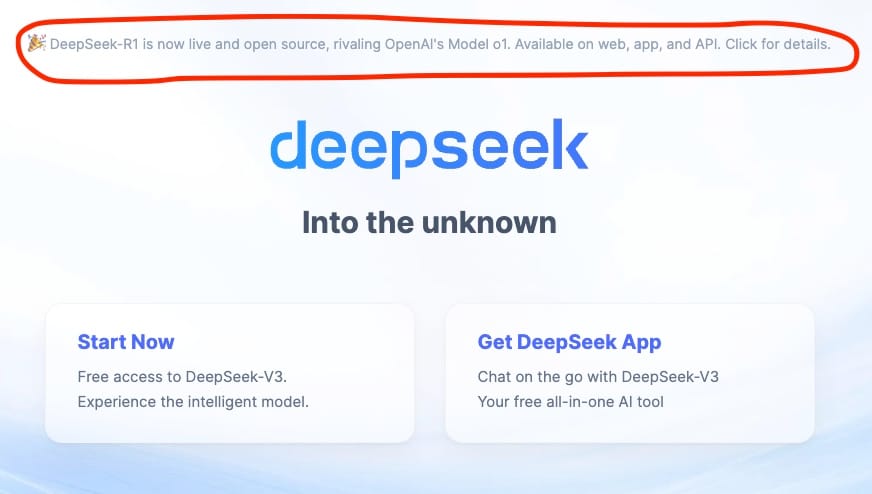𝗗𝗲𝗲𝗽𝗦𝗲𝗲𝗸 𝗥𝟭 𝗪𝗲𝗻𝘁 𝗩𝗶𝗿𝗮𝗹 𝗮𝗻𝗱 𝗦𝗵𝗼𝗼𝗸 𝘁𝗵𝗲 𝗠𝗮𝗿𝗸𝗲𝘁 🌍🤯—𝗛𝗲𝗿𝗲’𝘀 𝗪𝗵𝗮𝘁 𝗜 𝗟𝗲𝗮𝗿𝗻𝗲𝗱 📖✨

Every once in a while, an innovation comes along that shakes up the status quo, making us rethink what’s possible. DeepSeek R1 is one of those game-changers. This AI model is more than just an incremental improvement—it’s a bold leap forward, bringing fresh ideas to the table and challenging established players like OpenAI.
And here’s the kicker: DeepSeek R1 achieved this groundbreaking progress at just a fraction of the cost of its competitors. Curious? Let me walk you through its most impressive feats and why it’s creating such a buzz in the AI community.
Reinventing Training with Reinforcement Learning
Unlike most AI models that depend on mountains of carefully annotated data, DeepSeek R1 takes a different route. It relies solely on reinforcement learning (RL)—a technique that teaches the model by rewarding it for making accurate and useful decisions. No human-annotated datasets, no traditional fine-tuning.
This RL-first approach sets DeepSeek apart. Using a method called Group Relative Policy Optimization (GRPO), it sidesteps the need for a separate "critic" model (typically used to evaluate decisions during training). The result? A streamlined process that’s laser-focused on teaching the model to reason effectively.
Case in point: the early version, DeepSeek R1-Zero, crushed it on the AIME 2024 benchmark, scoring a remarkable 71% accuracy. All this, without following the beaten path of traditional training. How cool is that?
Smashing the Myth of AI’s Billion-Dollar Price Tag
If you thought groundbreaking AI innovation required sky-high budgets, DeepSeek R1 is here to prove otherwise. The team behind it managed to create this model with just $5.58 million—yes, million, not billion. Compare that to OpenAI’s rumored $6 billion investment, and it’s clear why DeepSeek R1 is turning heads.
But the efficiency doesn’t stop there. Training DeepSeek R1 took just 2.78 million GPU hours, compared to the 30.8 million hours used by Meta for similar endeavors. Talk about doing more with less.
By lowering the cost barrier, DeepSeek R1 is opening up new opportunities for smaller companies, startups, and even independent developers to get involved in cutting-edge AI work. And here’s the cherry on top: it’s open-source, with an MIT license. That means anyone can access, adapt, and innovate on top of this powerful model.
Built for Collaboration and Transparency
One thing that really struck me about DeepSeek R1 is its commitment to explainability—a feature that’s often overlooked in the AI space. With built-in tools to help visualize and understand its decision-making process, this model isn’t just powerful; it’s approachable and transparent.
This is a huge win for industries like healthcare and finance, where trust is paramount. Imagine doctors or financial analysts being able to see why an AI suggested a particular course of action. It’s a step toward making AI not just smarter but also more trustworthy.
And did I mention its multi-agent learning capabilities? This means DeepSeek R1 can coordinate complex tasks among multiple agents, from optimizing logistics to autonomous driving. It’s teamwork, but for machines.
Outperforming on a Budget
When it comes to performance, DeepSeek R1 isn’t just keeping up—it’s often leading the pack. Its strengths lie in tasks that demand reasoning and problem-solving, like Chain of Thought (CoT) reasoning, where it can break down complex queries into logical steps.
While OpenAI’s o1 model edges ahead in coding precision and math, DeepSeek R1 holds its own in reasoning-heavy scenarios. And thanks to its distilled variants—smaller, cost-efficient versions—it’s accessible even to developers with consumer-grade hardware.
In short: DeepSeek R1 delivers elite performance at a fraction of the cost, proving that innovation doesn’t have to break the bank.
Driving an Open AI Revolution
Let’s talk about the elephant in the room: open-source AI. DeepSeek R1’s decision to go open-source is a bold move in a landscape dominated by proprietary systems. By making its technology freely available, it’s leveling the playing field and encouraging collaboration across the global AI community.
This democratized approach doesn’t just invite developers to improve and customize the model—it challenges the status quo. Big players like OpenAI and Google now face a compelling question: can they keep up with the pace of open, community-driven innovation?
What This Means for the Future
DeepSeek R1 isn’t just an AI model; it’s a statement. It’s a reminder that with the right ideas, even smaller teams can disrupt billion-dollar industries. It’s a challenge to rethink how we balance performance, cost, and accessibility in AI development.
Looking ahead, models like DeepSeek R1 will likely spark even fiercer competition, driving the next wave of AI innovation. And as we embrace open, collaborative approaches, we’re inching closer to a future where AI is not just powerful but also ethical, sustainable, and inclusive.
So, whether you’re a developer, a researcher, or just someone fascinated by the potential of AI, keep an eye on DeepSeek R1. It’s not just reshaping how AI models are built—it’s redefining who gets to build them.
Continuing the Conversation:
Subscribe to my newsletter to stay connected with the latest frameworks, open-source tools, and best practices that will keep your enterprise at the forefront of trustworthy Generative AI innovation. Let’s continue charting a clear and confident path toward AI excellence—together.
References
- VentureBeat: DeepSeek R1’s Bold Bet on Reinforcement Learning
- Tom’s Guide: DeepSeek R1’s Disruption
- Medium: DeepSeek R1 Democratizing Advanced AI
- C3 UNU Blog: Pioneering Open Source
- The Hill: What Is DeepSeek?
- Shelly Palmer: DeepSeek R1’s Redefinition of AI
- DeepSeek Blog: Breakthrough
- MIT Technology Review: DeepSeek’s Top AI
- Techopedia: DeepSeek vs OpenAI
- Indian Express: DeepSeek’s Impact
- OpenTools AI: Billion-Dollar Budgets?
- GeeksforGeeks: DeepSeek R1 Updates
- CNN: DeepSeek Explained